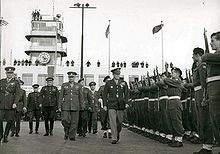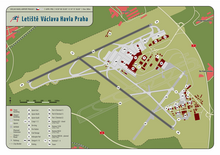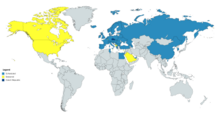Vaclav Havel Airport Prague
| Václav Havel Airport Prague Letiště Václava Havla Praha Václav Havel Airport Prague |
|
|---|---|

|
|
| Characteristics | |
| ICAO code | LKPR |
| IATA code | PRG |
| Coordinates | |
| Height above MSL | 380 m (1247 ft ) |
| Transport links | |
| Distance from the city center | 15 km west of Prague |
| Street |
|
| Local transport | Bus 100, 119 and Airport Express (AE) |
| Basic data | |
| opening | April 5, 1937 |
| operator | Letiště Praha, as |
| Terminals | 3 and GAT |
| Passengers | 16,797,006 (2018) |
| Air freight | 80,915 t (2018) |
| Flight movements |
155,530 (2018) |
| Capacity ( PAX per year) |
approx. 22.3 million |
| Employees | 14,000 |
| Runways | |
| 04/22 (closed) |
2120 m × 60 m asphalt concrete |
| 06/24 | 3715 m × 45 m concrete |
| 12/30 | 3250 m × 45 m concrete |
The Vaclav Havel Airport Prague , until October 2012 Prague-Ruzyně Airport , is the international passenger airport of the Czech capital Prague and is Ruzyně in the sixth Prague district, 15 km west of the city center. It is owned by the Czech state. It is the home airport and hub of Czech Airlines .
Location and transport links
The airport is located about 15 kilometers west of Prague city center in the area of the Ruzyně district. Terminals 1 and 2 can be reached via junction 30 of Dálnice 7 , while GAT and Terminal 3 are also connected to D 7 via junction 28 . Dálnice 6 , which is connected to the D 7 by a motorway junction , also begins south of the airport .
From the Nádraží Veleslavín metro station ( metro line A ), bus line No. 119 runs regularly (every 5 to 10 minutes) to the airport ( letiště in Czech ) during the day , from the Zličín metro station (terminus of the metro) -Bahn line B ) the bus line No. 100, both of which can be used with a normal public transport ticket . In addition, the Airport Express bus runs every half hour from Prague Central Station during the day and has a special tariff. At night, the airport is served by bus line 910 every 30 minutes. An extension of the underground line A to the airport is being discussed.
history
Civil air traffic in Czechoslovakia began in 1919 at the actually military airport in Prague-Kbely . However, the airport quickly reached its capacity limits, so that the government began building a civil airport near Ruzyně in 1933. The airport opened on April 5, 1937 and was awarded a gold medal at the Paris World Exhibition that same year . The airport area initially only covered an area of 108 hectares. In the following two years it was expanded to three times its size.
On March 16, 1939, Adolf Hitler proclaimed the Protectorate of Bohemia and Moravia . On the same day, the airport was occupied by the German Wehrmacht and an Air Force aircraft landed. The air force then set up a school for bomber pilots. As a result, there were more frequent bomb attacks. On May 5, 1945, the German command was asked to surrender. The German soldiers left the airport on the night of May 7th to May 8th, 1945. On May 8th, 1945 the airport began to be prepared for civilian operations.
After the end of the war, many people who had fled the National Socialists came back to Czechoslovakia via the airport. For a short time the Allied military transports took place. On September 8, 1945, Karl Hermann Frank landed in a special plane coming from Frankfurt am Main and was then taken to the Pankrác prison. On October 12th of the same year, Dwight D. Eisenhower landed at the airport to visit the city.
With the beginning of communist autocracy, western aircraft types gradually disappeared. The ČSA converted the fleet to Soviet aircraft models, so that the image of the airport in the next few decades was mainly shaped by aircraft from Ilyushin and Tupolev . At the end of 1957, ČSA took over the first Tupolev Tu-104 and heralded the age of jet traffic at Prague Airport.
In connection with the international détente in Czechoslovakia in the 1960s, the number of traffic increased, which, together with the increasing use of longer runways and space-consuming jet aircraft, made an expansion of the airport necessary. From 1958 to 1959, the runway (SLB) 12/30 was provisionally extended to 2620 meters, later to 3250 meters, and between 1960 and 1968 the construction of a new building complex, today's Terminal North, with parking spaces and air traffic control - Supply and shipyard buildings, and a new rail system with a focus on the new main SLB 06/24 with initially 3100 and later 3715 meters in length. The older SLBs 04/22 and 08/26 were then only used as branch lines.
The assault of the Warsaw Pact armies to crush the Prague Spring who made civil disobedience of the staff of the airport headlines. When the first Soviet troop transports landed, the director had all control centers (for the power supply, etc.) switched off in the late evening of August 20, 1968, thus paralyzing flight operations. With this, the airport employees prevented - at least for a certain time - the landing of further invaders.
There were no major expansions at the airport in the 1970s and 1980s. Due to the lack of fuel, all shorter domestic flights had to be suspended in the early 1980s.
After the political change , a new wave of construction and renovation began in 1989. First, the terminal building was renovated and expanded. In 1997 the South Terminal was opened. On January 17th, 2006 the opening of the newly built Terminal North 2 took place with the participation of the then President Václav Klaus .
On October 5, 2012, Praha-Ruzyně Airport was named after Václav Havel, who had died in December . On that day he would have been 76 years old.
The airport has been served by the Airbus A380 on scheduled flights since May 2016 . Emirates uses the A380 on the route to Dubai .
Infrastructure
Start-and runway
The airport has three runways, but one of them is closed and serves as a parking area for aircraft. The closed southeast runway 04/22 was originally built in 1937 as a 950 m long grass runway. It was last expanded in 1977, and since then it is 2300 m long and 60 m wide. In the south of the airport site it crosses the 3250 m long and 45 m wide Südwestbahn 12/30. It was built in 1937 as an 800 m long grass runway and was last expanded in 1977. This runway is approved for all-weather flight operations level ILS CAT-I. In the northeast of the airport site, it crosses the 3715 m long and 45 m wide northwest runway 06/24. This runway was built in 1963 with a length of 3115 m. The last expansion took place in 1982. It is now the most frequently used runway at the airport and is approved for all-weather flight operations level ILS CAT-IIIb.
There are also plans to build another runway. It is to be built next to the closed runway 04/22 and run parallel to runway 06/24. This should enable the simultaneous use of two runways.
Terminals
The rest of the infrastructure is spread over two locations on the airport grounds. The terminal used for government flights is located together with Terminal 3 southeast of runway 04/22. Terminals 1 and 2 are on the other side of runway 04/22 and east of Südwestbahn 13/31.
The airport's first terminal went into operation when the airport opened in 1937. It was planned by the architect Adolf Benš and was awarded a gold medal for its architecture at the Paris World Exhibition in 1937 . From 1937 until the occupation of the country in 1939 it was used for civilian purposes. It was used by the German Air Force until the country was liberated in 1945 . Civil use took place again until 1968. Today it is used by the Czech Ministry of Defense for government flights.
In 1968 the scheduled and charter flights were relocated to the newly built Terminal North. Today this is part of Terminal 1, which was built in 1997. All flights to or from non-Schengen countries are handled in Terminal 1. The passenger boarding bridges are distributed between piers A and B. The terminal has a capacity of 6.8 million passengers per year.
Shortly after Terminal 1, Terminal 3 went into operation in 1997. It is mainly used by general aviation including business aviation . However, the flights to Braunschweig operated by Czech Airlines were an exception .
Terminal 2 was last opened in 2006. This is where all flights to and from the Schengen area are handled. The passenger boarding bridges are located directly at the terminal and at Pier C. The terminal has a capacity of 15.5 million passengers per year.
There is also a connecting building with a few shops and a viewing terrace between Terminal 1 and 2.
Hangars
Czech Airlines operates a maintenance hangar at the airport, which was completed in 1969 and is located east of Terminal 1.
Travel Service's maintenance hangar is located south of Terminal 3, along with general aviation hangars.
Other facilities

The airport control tower is located behind the connecting building between Terminal 1 and 2 . It started operations in 1972. The old control tower is on the government terminal.
The freight terminal is located to the east of Terminal 2.
Czech Airlines' head office is located west of its own maintenance hangar. In addition, Czech Airlines operates a training center with flight simulators south of the government terminal .
Travel Service is also headquartered at the airport, north of the Czech Airlines maintenance hangar.
Airlines and Destinations
Prague Airport is the home airport of several airlines. In addition to the Czech flag carrier Czech Airlines , these are Travel Service including the subsidiary Smart Wings , ABS Jets and Grossmann Jet Service .
There are also numerous foreign airlines at the airport. Wizz Air uses the airport as its base, but plans to close it in mid-June 2018. EasyJet , Jet2.com , Norwegian Air Shuttle , Ryanair and Volotea also fly to at least five different destinations. Most other airlines only fly to one destination.
There are also scheduled flights to Africa , Asia and North America . However, a large part of the passenger volume is accounted for by connections within Europe .
Traffic figures

| year | Passengers | Flight movements | Air freight (t) |
|---|---|---|---|
| 2018 | 16,797,006 | 155,530 | 80,915,290 |
| 2017 | 15,415,001 | 148.283 | 81,879,598 |
| 2016 | 13,074,517 | 136,766 | 71,090.866 |
| 2015 | 12,030,928 | 128.018 | 50,595.299 |
| 2014 | 11,149,926 | 125,437 | 50,897.792 |
| 2013 | 10,974,196 | 128,633 | 51,902,062 |
| 2012 | 10,807,890 | 131,564 | 52,977,518 |
| 2011 | 11,788,629 | 150.717 | 62,688.977 |
| 2010 | 11,556,858 | 156.052 | 58,275,038 |
| 2009 | 11,643,366 | 163.816 | 42,476.207 |
| 2008 | 12,630,557 | 178,628 | 47,870,804 |
| 2007 | 12,436,254 | 174,662 | 55,179,554 |
| 2006 | 11,581,511 | 166,346 | 54,972,899 |
| 2005 | 10,777,020 | 160.213 | 51,730,450 |
| 2004 | 9,696,413 | 144,962 | 52,085.989 |
| 2003 | 7,463,120 | 115,756 | 41,439.783 |
| 2002 | 6,314,653 | 103.904 | 34,828.753 |
Busiest routes
The busiest routes in 2018 were:
| rank | Airport | Passengers |
|---|---|---|
| 1 |
|
755.935 |
| 2 |
|
712.414 |
| 3 |
|
690.857 |
| 4th |
|
524.302 |
| 5 |
|
506,462 |
| 6th |
|
443.741 |
| 7th |
|
432,521 |
| 8th |
|
408.188 |
| 9 |
|
388,847 |
| 10 |
|
329.181 |
| 11 |
|
320.440 |
| 12 |
|
314.504 |
| 13 |
|
304,880 |
| 14th |
|
304.417 |
| 15th |
|
291,604 |
| rank | Country | Passengers (2011) |
|---|---|---|
| 1 |
|
1,162,114 |
| 2 |
|
1,138,899 |
| 3 |
|
1,017,899 |
| 4th |
|
872.933 |
| 5 |
|
856.849 |
Incidents
- On October 30, 1975, a Douglas DC-9-32 of Inex-Adria Aviopromet ( aircraft registration YU-AJO ) coming from Tivat crashed on a hill eight kilometers from the airport. At the time of the accident there was fog with visibility below 1500 m; the fully functional machine was flown below the safe decision height and even below the airport height. 75 of the 120 aircraft occupants died.
Web links
- Airport website (Czech / English / Russian / German)
- Prague airport info
Individual evidence
- ↑ a b c d e Prague Airport Traffic Reports. PRG.aero, accessed February 2, 2019 .
- ↑ a b About us. PRG.aero, accessed January 20, 2018 .
- ↑ AIP Czech Republic . ( PDF file with S. AD 2-LKPR-9 (182 KiB) , PDF file with S. AD 2-LKPR-26 (492 KiB) , PDF file with S. LKPR AD-2-19-1 ( 596 KiB) [accessed December 5, 2014] AD 2-LKPR-9, AD 2-LKPR-26, LKPR AD-2-19-1; last corrections: AIRAC AIP AMDT 8/14, AIP AMDT 297/14 ( both in force from November 13, 2014)).
- ^ Transport - By car. PRG.aero, accessed on January 23, 2017 .
- ↑ http://jrportal.dpp.cz/jrportal/LineList.aspx?t=3&mi=5&n=0&lc=119&d=2014-10-01 accessed on November 15, 2014.
- ↑ OB Krnáčová: Prague does not plan to extend the metro to the airport , Český rozhlas, February 24, 2015, accessed on March 28, 2015.
- ↑ Vladimir Ustohal: Expansion of the Prague – Ruzyně airport . In: Heinz A. F. Schmidt (Ed.): Flieger-Jahrbuch 1966 . Transpress, Berlin 1965, p. 94-100 .
- ^ Roland Vogt : Forms of resistance in the CSSR as a response to the intervention of the Warsaw Pact troops on August 21, 1968 . In: Soziale Defense , Vol. 3 (1971), Issue 9/10, pp. 60–70, here pp. 63–64.
- ↑ Stories from 70 years of Prague Airport , Český rozhlas, April 7, 2007, accessed on March 29, 2015.
- ↑ Birthday present for Václav Havel - Prague Airport renamed , Český rozhlas, October 5, 2012, accessed on March 29, 2015.
- ↑ Emirates Announces Daily A380 Service to Prague. (No longer available online.) In: prg.aero. December 17, 2015, archived from the original on July 4, 2016 ; Retrieved July 4, 2016 . Info: The archive link was inserted automatically and has not yet been checked. Please check the original and archive link according to the instructions and then remove this notice.
- ↑ Airport Map. (No longer available online.) In: prg.aero. Archived from the original on March 24, 2016 ; accessed on March 17, 2016 . Info: The archive link was inserted automatically and has not yet been checked. Please check the original and archive link according to the instructions and then remove this notice.
- ↑ Wizz Air closes its base in Prague. aeroTELEGRAPH.com, January 24, 2018, accessed January 25, 2018 .
- ↑ Airlines and destinations. In: prg.aero. Retrieved July 4, 2016 .
- ^ Accident report DC-9-30 YU-AJO , Aviation Safety Network (English), accessed on April 2, 2016.







